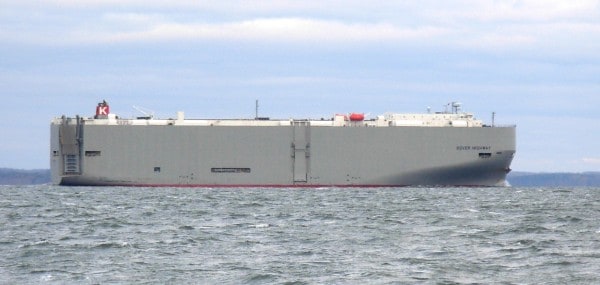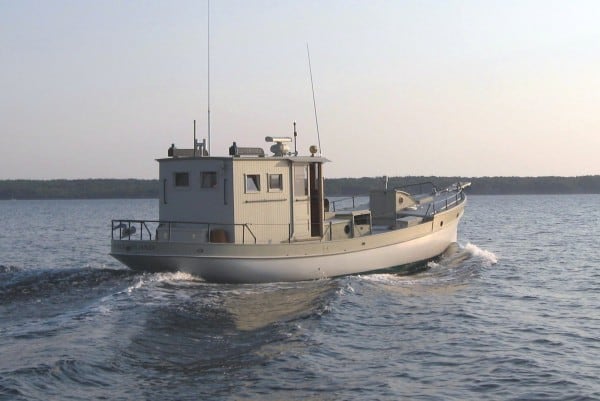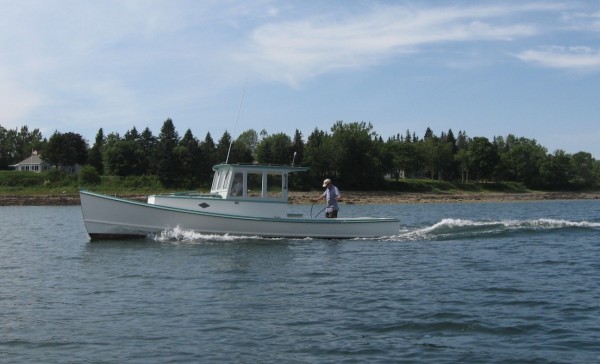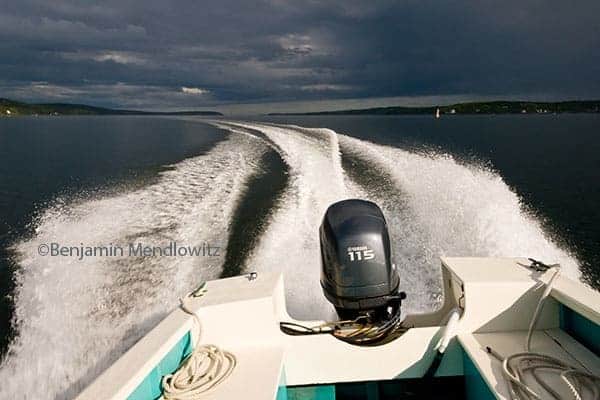Email This Page to a FriendNotes on Boat Design, Part II—Three Basic Hull Types
All Guide Posts » The Right Boat » Boat Design
November 27, 2012
HULL TYPE I
Let’s start with a typical sailboat type hull, with a fairly fine bow and the transom up out of the water. Let’s say it has a waterline length of 25 feet, and a motor of limitless power. We put her in gear, and as we begin to move, the hull creates a series of ripples. As power and speed are increased, these ripples become bigger and farther apart, until at some point the length of the created wave equals the waterline length of the boat. Because the trough of the wave is at the middle of the waterline, the boat actually sinks a little bit.
At this point, our boat is said to be going “hull speed.” To get a tiny bit technical, a study of waves will show that a wave will travel at 1.3 times the square root of the distance between the wave crests (speed in knots, distances in feet). Even heavy boats can push this theoretical hull speed a bit, so while the minimum hull speed is considered to be 1.34 times the square root of the waterline length, or in our case 6.7 knots, a very light and narrow boat can be pushed a bit faster—up to 2 times the square root of the waterline length.
HULL TYPE II
Back in our boat, we push the throttle ahead a bit more. Now, this type of boat will try to climb up it’s bow wave – the stern will start to sink into the trough, and if we persist in this fashion, the stern will submerge and the boat will likely sink, all while going barely over hull speed. Very disappointing.
Luckily, we have a magic boat that can change shape as we go along! It makes sense that, since the stern is squatting down and threatening to flood, we should make the stern wider and deeper to get more buoyancy there. This has the effect of flattening out the running lines (the path along which the water moves as it travels past the aft part of the hull’s bottom). Now we’re cookin’ and can gracefully go at up to 3 times the square root of the waterline length, which means 15 knots—so-called semi-displacement speed.
But being homo sapiens with an engine of limitless power, we push the throttle even further ahead. Water starts to sheet up the side of the hull until we are surrounded by a liquid curtain. This dramatically increases our resistance due to wetted surface, and it spoils the view. Time to change our hull shape again.
HULL TYPE III
We tighten up the curve where the bottom surface meets the topsides, creating a knuckle called a chine that throws the spray aside and away from the hull. We make the stern even wider and deeper so that the running lines are now straight as an arrow. The water hits the aft portion of the hull’s bottom with such force that it actually lifts the boat up, further reducing wetted surface. We’re planing! With a diabolical cackle, we push the throttle ahead until we’re really flying, with just a small portion of the hull left in the water. Then we run out of gas.
If we had been watching our engine’s guzzleometer, we would have noticed that our energy consumption had gone from next to nothing when we first put the engine in gear, to a truly impressive number just before we ran out of gas. Clearly, all we need is to find a fuel tank of limitless capacity, and a wallet of unfathomable depth.
Here are some examples of each type in increasing speed-length ratios:
A “handsome” modern cargo vessel moving at well under hull speed. The DOVER HIGHWAY has a length of about 600 ft. and is traveling at approximately 15 knots in this photo. Regardless of the size of the boat, one horsepower can move about 5,000 pounds at this speed-length ratio of 0.61. I crossed her wake about two minutes after this photo was taken and it was barely noticeable.
The power cruiser DELIVERANCE traveling at hull speed, or S/L of 1.34. At a waterline length of 38.5 feet, this gives 8.5 knots. Given her shape and weight, this is about as fast as she can go, with a wave crest at each end and the trough in the middle. Each horsepower is moving about 500 pounds. It should be mentioned that there are two kinds of waves being made in this photo. First there are the bow waves that move away from the path of the boat at an angle. We tend to refer to these waves as the wake, because they are the annoying things that we have to deal with when made by others. The second wave train is aligned perpendicular to the path of the boat and moves along with it. These are the waves that limit the speed of a displacement type hull. A semi-displacement type hull fools these waves into thinking that the hull is longer than it really is. A true planing hull leaves these waves far behind, like an airplane that has broken the sound barrier.
BRENDA KAY moving at a semi-displacement speed, in this case about 15 knots. Her light weight, broad stern, flattened run and bigger engine allow her to exceed hull speed. In this case her speed length ratio (S/L) is 3.0. Note that the crest of her stern wave is well aft of the boat, and that the stem has overtaken the bow wave. One horsepower is moving about 80 lbs.
The wake of the Albury runabout ABACO running at true planing speed, or about 33 knots. There is no stern wave in evidence, although there is a “bow” wave that travels nearly perpendicular to the path of the boat. The S/L in this case is 7.8, but at these speeds, waterline length is no longer the primary factor in fuel consumption. The speed, weight, and the shape of the planing surface (largely the deadrise angle) are more important. Each horsepower is moving only 21 pounds at this speed.
Comments, Thoughts or Suggestions?
You can leave a comment or question for OCH and members below. Here are the comments so far…
6 Responses So Far to “Notes on Boat Design, Part II—Three Basic Hull Types”:






One of the most useful articles I have read on this subject.
It’s great to find a concise explanation, with illustrations, and without formulas. I would like to put in a request for a follow-on blog in which the key question is: how fast should you go under motor power in rough weather – high waves and high wind speed? Obviously in Type 1 hulls you are spending increasing horsepower just getting through those waves, which will start slamming against the bow if you don’t allow the boat to ride over them. Sometimes this is not an entirely theoretical question because you need to get to a safe harbor or river before you run out of fuel, and you do not want to be tacking upwind in a narrow channel with rocks and/or shallows on both sides – you want to go upwind with the motor, in a channel like that. In addition you need the motor to escape a violent thunderstorm on the horizon that is coming in your direction. So how fast should you go?
That is a pretty complicated question. With any boat in calm conditions, the slower you go, the less fuel you will use per mile. But if you are going into a head wind, you will have to run the engine hard enough to make some headway, or else your fuel consumption will be infinite. Ever read GRAY SEAS UNDER by Farley Mowat? In this great history of the amazing ocean salvage tug FOUNDATION FRANKLIN Mowat describe how the tug would make absolutely no headway, sometimes for days, with engines wide open, trying to keep a heavy tow off a lee shore in a storm.
How fast you should go under the various conditions you describe will depend on so many factors — what type of boat you have, how she handles in various conditions, how much fuel you have in the tank, time of day, wind direction, etc. etc. A skipper must know his boat well in order to get the best out of her.
Finally! After 48 years on boats, I think I get it! Great description, Doug. Thanks.
Very clear and informative, thanks for making these concepts easily understood.
Always a pleasure Doug, thanks for that.